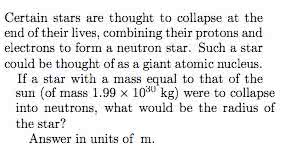AST201H1 Lecture 12: Lecture 12 Notes

24
AST201H1 Full Course Notes
Verified Note
24 documents
Document Summary
Due to the higher compression its extra gravity provides, massive stars can fuse elements all the way up to iron. Once a massive star"s core stops burning, its own gravity wins out over pressure and starts crushing it. Low-mass stars stop collapsing because their electrons refuse to get close together; massive stars get around this by simply destroying their electrons. In seconds, most of the star"s core is turned into neutrons. Further collapse is prevented by neutron degeneracy pressure. Meanwhile, the rest of the star is rushing inward at about 20% of the speed of light. I t suddenly hits a stationary ball of neutrons the size of. The inrushing material rebounds explosively and the star tears itself apart. When supernovae occur in our part of the galaxy, people notice. In the past, they have been so bright that they were said to appear in the sky like a second sun giving people a second shadow.


